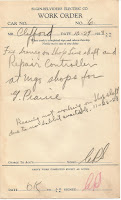Another productive Saturday has come and gone. So let's see a little of what was happening in the car shop. We'll start with the 1754.
Tim has varnished all of the center ceiling panels, and two of them were still sitting here on the bench.
One of them had been put in place at the east end of the car, but it was then realized it belonged at the west end. Here Ed Woytula is looking up at the false ceiling. That's actually about where the actual false ceiling was before restoration started. It's not easy moving these panels about, so Ed and I spent a while helping get this one into place. Tim had prepared several boards wrapped with rags to avoid scratching the mirror-like finish.
Notice that both numbers (pre- and post-merger) were painted onto the ends of the car.
Now the panel is in the right place, and needs to be forced up and slightly bent in place.
And a couple of hours later, Tim was finishing up trimming the panel, which is essentially in place. The interior is going to look just as nice as the others.
And then work continues on the ex-Shaker truck for the Cleveland PCC. Chuck Meter has been cleaning up the big, heavy actuators for the brakes. There's four per truck.
Ed Woytula is back on his main project, and with Chuck and Dan Fenlaciki they're working on disassembling some more parts of the truck.
This kit didn't come with any instructions. That's what happens when you buy trains on eBay.
And here are the newly repainted planks for the bunk in Victor's cabin car.
Buzz proudly shows off the new window frames he's making for the Green Bay car.
And Bob Sundelin is making trolley shoes on the new milling machine. This is what he does best.
And speaking of Bob Sundelin, he and I discussed the 309 bearing project some more. Among other things, our friend Jeff Hakner from Branford has provided us with extremely detailed recommendations that will be very useful. Right now we're mostly waiting for the big oven to get wired up.
And beyond the 309 bearing project, we need to replace one wheelset in the motor truck of the 36. The treads on this wheelset are too thin, and in fact the wheels are about 1 1/4" smaller than the other wheelset in the truck. I did some walking around, and determined that we can probably replace the wheelset with one originally from the 318, which is now under the 321. We need to match the diameter of the wheels, the size of the axles, the exact type of gear, and check that the flanges are good. The 318 was equipped with GE66 motors, so it looks like everything matches. Among other things, I opened up the container to check on the spare GE 66's we have, two of which came from the 318, and I'm quite sure the 318 gear will match the 36's pinion, if you see what I mean. It will be very fortunate if we can avoid having to press wheels on and off the axle, or other difficult and expensive operations. Changing out the complete wheelset will take some work, but the out-of-pocket cost should be essentially zero. And we always worry about bending the axle when wheels have to be pressed on. For the immediate future, the 36 will still be cleared for occasional service, but the wheel project will continue. First we'll need to swap a truck under the 321, which is at the west end of track 113. That's a lot of switching.
And I spent some more time sorting and storing parts. What fun!













































